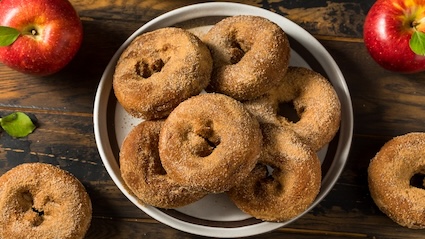From salty ham to barbecue and peanut pie, the Commonwealth’s culinary roots run deep. Beloved recipes and cooking traditions have brought generations of Virginians together around kitchen tables, church potlucks, and holiday gatherings. While food trends may come and go, Virginia foodways – those traditional practices that shape how we grow, prepare, and share meals – continue to stand the test of time.
Seven unforgettable highlights of Virginia Foodways
1. A ham worth the hype
Ask a Virginian what foods best represent the state and they’ll probably mention Smithfield ham. To be called “Smithfield ham,” it must be processed and aged in the town of Smithfield, Virginia, where salt-curing and smoking techniques have been practiced since the 1700s. The result is a salty, firm, deeply flavored ham that’s traditionally sliced thin and served on biscuits, sandwiches, or with scrambled eggs. It often shows up on the table on Easter and Christmas.
2. Fried chicken with a side of history
While fried chicken is beloved across the South, Gordonsville, Virginia, holds a unique place in its story. In the 1800s, when railroads cut through Orange County, Black women sold freshly fried chicken, biscuits, and pies to hungry train passengers from the station platform. These savory meals, packed in baskets, quickly earned a reputation for taste and convenience – so much so that Gordonsville became known informally as the “Fried Chicken Capital of the World.”
This same region gave us Edna Lewis, one of America’s most celebrated chefs and food writers. Born in nearby Freetown in 1916, Lewis helped preserve and elevate traditional Southern and African American cooking, much of it deeply rooted in Virginia’s rural foodways. Her book “The Taste of Country Cooking” (1976) is a landmark in American food literature and includes many stories and recipes from her Virginia upbringing.
3. The power of the peanut
 Virginia’s love affair with peanuts runs deep, especially in the southeastern part of the state, where the sandy soil is perfect for growing them. Virginia peanuts are larger and crunchier than most, often roasted and salted for snacking and packed into containers that line country store shelves.
Virginia’s love affair with peanuts runs deep, especially in the southeastern part of the state, where the sandy soil is perfect for growing them. Virginia peanuts are larger and crunchier than most, often roasted and salted for snacking and packed into containers that line country store shelves.
Two of the state’s lesser-known delights are peanut pie and peanut soup. Similar to pecan pie but with a nuttier bite and other tweaks, peanut pie is often found at church bake sales and small-town diners. If you’ve never tried it, places like Wakefield or Emporia are known for producing some of the best. Peanut soup shows up around the commonwealth, especially at traditional restaurants such as Williamsburg taverns.
4. Brunswick stew and the great debate
Brunswick stew is a thick, hearty dish made with meat (traditionally chicken or pork, though originally squirrel meat was used!), tomatoes, lima beans, corn, and potatoes. It’s a stick-to-your-ribs meal that’s been served at fire halls and fall festivals for generations.
Virginia and Georgia have long argued over who invented it. Virginia’s version is said to have originated in Brunswick County, Virginia, where the Taste of Brunswick Festival is still held each October. Local stewmasters stir massive cast-iron pots over open flames, competing for the title of Best Brunswick Stew.
5. Straight from the Bay: oysters and crabs
Virginia’s Chesapeake Bay and surrounding rivers are home to some of the best blue crabs and oysters on the East Coast. The state has eight distinct oyster regions, each with its own flavor profile. These briny bivalves are the stars of the Urbanna Oyster Festival, held every November in the tiny waterfront town of Urbanna. The festival draws thousands and features live music, shucking contests, food vendors, and artisan markets.
6. Apples, mountains, and cider sips
 Head west to the Blue Ridge Mountains and you’ll find apple country. Virginia’s mountain climate is ideal for apple orchards, and many families make a tradition of picking their own fruit or sipping fresh cider every fall. Many orchards offer pre-picked fruits and homemade favorites like delicious apple cider doughnuts, cake-like delights dusted with cinnamon sugar.
Head west to the Blue Ridge Mountains and you’ll find apple country. Virginia’s mountain climate is ideal for apple orchards, and many families make a tradition of picking their own fruit or sipping fresh cider every fall. Many orchards offer pre-picked fruits and homemade favorites like delicious apple cider doughnuts, cake-like delights dusted with cinnamon sugar.
7. Born from fire: the roots of Virginia barbecue
While many states boast of their barbecue, Virginia claims the distinction of being the originator of pit-cooked barbecue, blending practices from three influential groups. Indigenous people had been cooking meat over smoldering wood long before Europeans arrived. In the 1600s, African arrivals brought their pit cooking heritage to the New World. While European colonists introduced the spices and vinegars for basting, the labor of chopping the trees, digging the pits, and perfecting the technique was all thanks to enslaved Blacks.
Today, Virginia barbecue still reflects those origins. Pork is usually chopped or pulled, and the sauce is often vinegar-based with just a touch of heat. You’ll find it at roadside joints, town festivals, and old-school family restaurants, especially in central and southern Virginia.
Preserving the past with Virginia foodways
Virginia foodways aren’t just about what’s on the plate – it’s about the people, traditions, and memories behind each bite. These dishes remind many of us of our grandparents’ kitchens, Sunday dinners after church, or summer evenings spent cracking crab shells by hand.
Thankfully, younger generations of Virginians – from chefs and farmers to home cooks and food lovers alike – are continuing these traditions. Whether you’re biting into a ham biscuit, sipping cider in the mountains, or sharing peanut pie with your grandchildren, you’re keeping a piece of Virginia’s story alive.





